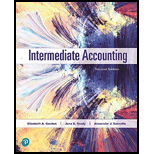
Intermediate Accounting (2nd Edition)
2nd Edition
ISBN: 9780134730370
Author: Elizabeth A. Gordon, Jana S. Raedy, Alexander J. Sannella
Publisher: PEARSON
expand_more
expand_more
format_list_bulleted
Question
Chapter 3, Problem 3.5BE
To determine
To identify: The three levels of the literature hierarchy for U.S. GAAP in the correct order, from 1 through 3.
Expert Solution & Answer
Want to see the full answer?
Check out a sample textbook solution
Students have asked these similar questions
General Accounting
Financial Accounting
What is your return for the year on these accounting question?
Chapter 3 Solutions
Intermediate Accounting (2nd Edition)
Ch. 3 - Prob. 3.1QCh. 3 - Prob. 3.2QCh. 3 - Does U.S. GAAP require that companies disclose...Ch. 3 - Does IFRS require that companies disclose...Ch. 3 - Prob. 3.5QCh. 3 - Does IFRS require that companies disclose their...Ch. 3 - Prob. 3.7QCh. 3 - Prob. 3.8QCh. 3 - Prob. 3.9QCh. 3 - Prob. 3.10Q
Ch. 3 - Prob. 3.11QCh. 3 - What is the Basis for Conclusions and where can...Ch. 3 - Prob. 3.13QCh. 3 - Prob. 3.14QCh. 3 - Prob. 3.1BECh. 3 - Judgment in Accounting for Plant and Equipment....Ch. 3 - Match Each Cognitive Bias Below with its...Ch. 3 - Prob. 3.4BECh. 3 - Prob. 3.5BECh. 3 - Prob. 3.6BECh. 3 - Prob. 3.7BECh. 3 - Codification Research. Referencing Appendix A,...Ch. 3 - Prob. 3.9BECh. 3 - Prob. 3.10BECh. 3 - Exercises E3-1. Accounting Policy Disclosures. To...Ch. 3 - Cognitive Bias. A team of accounting students is...Ch. 3 - Cognitive Bias. A team of accounting students is...Ch. 3 - Authoritative Literature. Provide the reference to...Ch. 3 - Authoritative Literature. Provide the reference to...Ch. 3 - Authoritative Literature. To what entity types...Ch. 3 - Authoritative Literature. How does FASB define...Ch. 3 - Prob. 3.8ECh. 3 - Prob. 1JCCh. 3 - Prob. 2JCCh. 3 - Prob. 1SSCCh. 3 - Surfing the Standards Case 2: Inventory...Ch. 3 - Basis for Conclusions Case 1: Judgment and...Ch. 3 - Basis for Conclusions Case 2: Income Statement or...
Knowledge Booster
Similar questions
arrow_back_ios
SEE MORE QUESTIONS
arrow_forward_ios
Recommended textbooks for you
 Intermediate Accounting: Reporting And AnalysisAccountingISBN:9781337788281Author:James M. Wahlen, Jefferson P. Jones, Donald PagachPublisher:Cengage Learning
Intermediate Accounting: Reporting And AnalysisAccountingISBN:9781337788281Author:James M. Wahlen, Jefferson P. Jones, Donald PagachPublisher:Cengage Learning Individual Income TaxesAccountingISBN:9780357109731Author:HoffmanPublisher:CENGAGE LEARNING - CONSIGNMENT
Individual Income TaxesAccountingISBN:9780357109731Author:HoffmanPublisher:CENGAGE LEARNING - CONSIGNMENT

Intermediate Accounting: Reporting And Analysis
Accounting
ISBN:9781337788281
Author:James M. Wahlen, Jefferson P. Jones, Donald Pagach
Publisher:Cengage Learning

Individual Income Taxes
Accounting
ISBN:9780357109731
Author:Hoffman
Publisher:CENGAGE LEARNING - CONSIGNMENT
